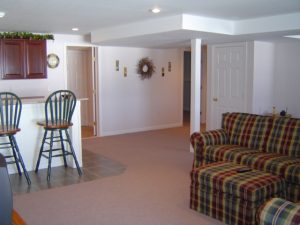Texturing Ceilings and Skip Troweling Instructions
By Mark J. Donovan
|
|
If you have no interest in having a popcorn ceiling, which I don’t blame you – its passé, then consider going with a textured ceiling. Learning how to texture a ceiling is quite easy and it starts with a bucket of premixed joint compound, a wide blade drywall taping knife, water, a large pail and a stirring stick.
Start by preparing the room that you plan to texture the ceiling. Remove all items from it and lay down heavy drop clothes on the entire floor, as this job gets quite messy. |
If you have wall paper or a wall paper border that goes to the ceiling, remove it as the water in the joint compound will wick into it and cause the wallpaper to separate from the wall.
After you have applied the ceiling texture mixture to about a 5’ x 5’ surface area of the ceiling, go back over the area and swirl the texture mixture with your taping knife to create a free-flowing curved texture. If you would like to experiment with a sponge or brush to create other textured ceiling looks go for it.
| Creating a Skip Towel Textured Ceiling
If you want to create a skip trowel textured ceiling, then you will want to have a slightly more watery ceiling texture mixture, such that when you apply it on the ceiling it begins to drip down, effectively forming stalactites. After the stalactites have begun to form, which should begin to occur within just a few minutes of applying the skim coat ceiling texture mixture, go back with your taping knife and “knock down” the stalactites, by again sliding your taping knife over the ceiling texture mixture. The finished looked is a textured ceiling that has random high and low spots. |
 |
After the textured ceiling joint compound mixture has fully dried you can paint the textured ceiling if you so choose.
For information on repairing a large drywall hole, see the “How to Repair a Large Drywall Hole” Ebook from HomeAdditionPlus.com. The “How to Repair a Large Drywall Hole” Ebook provides step-by-step instructions on how to repair your damaged wall so that it looks as good as new.
See HomeAdditionPlus.com’s Drywall Calculator
Related Information
Additional Drywall Installation Resources from Amazon.com
 |
 |
Free Home Addition Price Quotes with No Obligation!
Fill out our 3-5 minute quick and easy form, and receive a free price quote on a house addition from one of our prescreened and licensed home addition contractors. This process is free and there is no obligation to continue once you receive your house addition price estimate.

